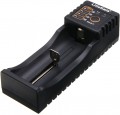Charging slots
The number of separate slots for batteries provided in the design of the charger.
The more such slots, the more batteries can be charged in the device at a time; “multi-charge” models (
charges for 4 batteries or more) will be especially useful in cases where you have to intensively use a large number of batteries. On the other hand, this feature significantly affects the dimensions, weight and cost of the “charger”. However, it is not so significant, therefore
there are models with 1 battery or
2 batteries less and they can be characterized as a tourist option.
Size
The battery sizes that the charger is compatible with. In this case, the adapters supplied in the kit (see below) are not taken into account in this paragraph, we are talking only about the memory as such.
The standard dimensions describes the shape, dimensions, connector design and operating voltage of the battery; thus, it is one of the most important parameters for determining compatibility with a particular charger.
The most popular sizes for which modern “chargers” are made can be divided into 1.5-volt (marked in Latin letters
AA,
AAA,
C,
D) and 3.7-volt (have digital markings
14500,
17500,
18650,
22650,
26650, etc. .P.). More about them:
— AAAA. The smallest version of the "finger" dimensions: batteries of the same cylindrical shape as the well-known AA and AAA, but with a size of only about 8 mm and a length of about 43 mm. Similar in application to AAA, but very poorly distributed.
— AAA. Size, colloquially known as "mini finger" or "little finger batteries": cylindrical batteries with a size of 10.5 mm and a length of 44.5 mm. They are mainly used in miniature devices for which there are not enough “tablet” bat
...teries, and larger elements are too bulky.
— AA. Classic "finger" batteries with a size of 14 mm and a length of 50 mm, one of the most popular modern standard sizes (if not the most popular). They are used in a wide variety of types and price categories of devices, including even external battery packs for SLR cameras.
- C. Batteries in the form of a characteristic "barrel". They are similar in height to finger-type AAs, but almost twice as thick - 50 mm and 26 mm, respectively - due to which they have a higher capacity.
- D. The largest dimensions of consumer grade 1.5V batteries, 34mm in size and 61mm in length. It is mainly used in high-power flashlights and devices with high energy consumption.
3.7-V batteries are indicated by a five-digit number. In it, the first two digits indicate the size (in millimeters), the remaining three indicate the length (in tenths of a millimeter). For example, the popular dimensions 18650 corresponds to a battery with a size of 18 mm and a length of 65.0 mm. It is worth noting here that there are 3.7-volt cells that are the same dimensions as the 1.5-volt ones described above (for example, the 14500 dimensions is similar to AA finger-type), but both types are not interchangeable due to the difference in voltage.
A separate category is 9-volt R22 batteries, also known as PP3: these are rectangular elements in which a pair of contacts is located on one of the ends.Independent charge channels
The number of independent charging channels provided in the design of the charger.
If the voltage, charging current and other parameters in this model are regulated on all battery slots at the same time, this means that the device has only one channel. The presence of several charging channels allows you to set your own operating parameters on separate slots and, accordingly, simultaneously charge different types of batteries in one device. In this case, the channel can cover both one slot and several: for example, many models for 4 batteries have only 2 channels (one for every 2 slots).
The abundance of channels expands the capabilities of the "charger" and will be especially useful in cases where you often have to charge different types of batteries; on the other hand, it significantly affects the cost of the device.
Charge current (all channels)
The highest current provided by a multi-channel charger (see "Independent channels") at full load, with all slots (and, accordingly, channels) operating. In fact, a guaranteed maximum current provided by a multi-channel charger, regardless of the number of channels involved.
For the total charge current, see “Maximum charge current. Here we note that the full load is a rather complex mode in which the current strength can decrease. Therefore, this parameter is specified separately.
Number of settings
The number of separate charge current settings (see above) provided in the design of the charger. For example, a device with 4 settings may provide options for 200, 400, 800 and 1000 mAh. In general, the larger this number, the more accurately you can choose the charging current for a particular situation.
Max. discharge current
The highest current that the device can provide in battery discharge mode.
Some specific functions are based on the discharge of the battery installed in the charger (see below for more details). The higher the maximum value of the discharge current, the less time it takes to “drain” energy from the battery. On the other hand, for some types of batteries and discharge modes, specific current recommendations may be provided, and exceeding them can be fraught with overload, overheating, and even fire. Therefore, it is necessary to specifically pursue high values of the discharge current only if it is justified from a technical point of view.

